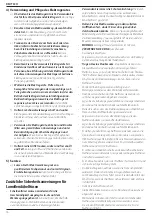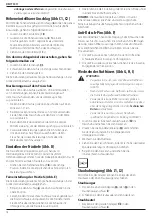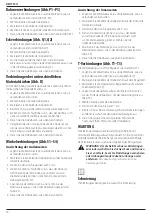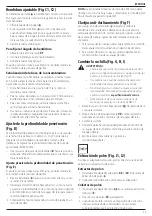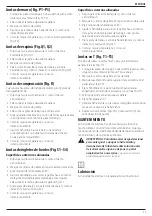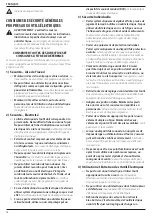
24
EngLIsh
Residual Risks
In spite of the application of the relevant safety regulations
and the implementation of safety devices, certain residual risks
cannot be avoided. These are:
• Impairment of hearing.
• Risk of injury when changing the disc.
• Risk of dust inhalation from materials that when cut, can
be harmful.
may make exposed metal parts of the power tool "live" and
could give the operator an electric shock.
•
MAXIMUM
allowed disc cutter diameter is 102 mm.
•
DO NOT
use blunt or damaged disc cutters.
• Check the proper function of the guard retracting system
before use.
•
Wear a dust mask.
Exposure to dust particles can cause
breathing difficulty and possible injury.
• Always ensure that the power tool is switched off before
plugging into the mains.
• Do not switch off before the blade is running freely.
• Remove all nails and metal objects from the workpiece before
starting work.
• After switching off, never attempt to stop the blade by pressing
against the side of the blade.
• Never put the tool down on a table or workbench unless
switched off.
• The tool must only be used for cutting wood or plastic.
• Ensure that all devices screening the blade are in perfect
working order.
• Never put the tool down on a table or workbench unless
switched off.
• Only blades conforming to the specifications contained in
these operating instructions may be used.
• Blades made of high alloy, high-speed steel (HSS steel) should
not be used. Best results are achieved using carbide-tipped or
CrV blades.
• Only sharp blades in perfect working order should be used;
cracked or bent blades should be discarded and replaced
at once.
• Ensure that the blade is securely fixed and rotates in the
correct direction.
• Kickback occurs when the tool begins to stall rapidly and
is driven back towards the operator. Release the switch
immediately if the blade sticks or the tool stalls.
• Keep the blades sharp.
• Support large panels near the cutting area.
• Do not remove the tool from the workpiece while making a cut
with the blade rotating. Release the on/off switch and wait for
the blade to come to a halt.
Additional Specific Safety Rules for the
Biscuit Jointer
•
Disc cutters must be rated for at least the speed marked
on the tool.
Disc cutters running over rated speed can fly
apart and cause injury.
•
Always use the guard.
The guard protects the operator from
broken disc cutter fragments and unintentional contact with
the disc cutter.
•
Hold power tool by insulated gripping surfaces, because
the cutter may contact its own cord.
Cutting a "live" wire
h )
Do not let familiarity gained from frequent use of
tools allow you to become complacent and ignore
tool safety principles.
A careless action can cause severe
injury within a fraction of a second.
4) Power Tool Use and Care
a )
Do not force the power tool. Use the correct power
tool for your application.
The correct power tool
will do the job better and safer at the rate for which it
was designed.
b )
Do not use the power tool if the switch does not turn
it on and off.
Any power tool that cannot be controlled
with the switch is dangerous and must be repaired.
c )
Disconnect the plug from the power source and/
or remove the battery pack, if detachable, from
the power tool before making any adjustments,
changing accessories, or storing power tools.
Such
preventive safety measures reduce the risk of starting the
power tool accidentally.
d )
Store idle power tools out of the reach of children
and do not allow persons unfamiliar with the power
tool or these instructions to operate the power tool.
Power tools are dangerous in the hands of untrained users.
e )
Maintain power tools and accessories. Check for
misalignment or binding of moving parts, breakage
of parts and any other condition that may affect the
power tool’s operation. If damaged, have the power
tool repaired before use.
Many accidents are caused by
poorly maintained power tools.
f )
Keep cutting tools sharp and clean.
Properly
maintained cutting tools with sharp cutting edges are less
likely to bind and are easier to control.
g )
Use the power tool, accessories and tool bits etc.
in accordance with these instructions, taking into
account the working conditions and the work to be
performed.
Use of the power tool for operations different
from those intended could result in a hazardous situation.
h )
Keep handles and grasping surfaces dry, clean and
free from oil and grease.
Slippery handles and grasping
surfaces do not allow for safe handling and control of the
tool in unexpected situations.
5) Service
a )
Have your power tool serviced by a qualified repair
person using only identical replacement parts.
This
will ensure that the safety of the power tool is maintained.
Summary of Contents for DW682
Page 1: ...DW682 ...
Page 3: ...1 Fig A 3 4 10 9 5 17 2 8 7 11 6 1 ...
Page 4: ...2 Fig B Fig C1 Fig C2 Fig D Fig E Fig F Fig G Fig H 2 1 11 6 9 4 8 6 7 12 ...
Page 6: ...4 5 7 5 cm 15 25 cm 15 25 cm Fig M4 Fig N Fig O1 Fig O2 Fig P1 Fig P2 Fig P3 Fig Q1 ...
Page 7: ...5 Fig Q2 Fig R Fig S1 Fig S2 Fig T1 Fig T2 Fig S3 Fig S4 ...
Page 8: ...6 Fig T3 Fig T4 Fig T5 Fig U 3 16 ...
Page 106: ......
Page 107: ......







